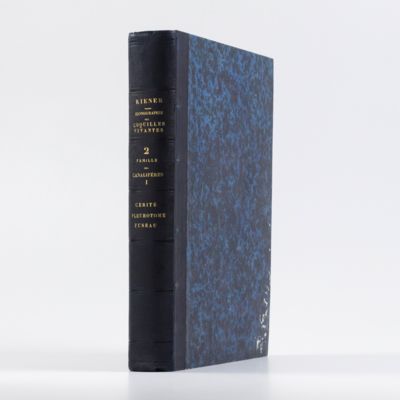Kiener, L. C.
Spécies générales et iconographie des coquilles vivantes comprenant la collection du Muséum d'Histoire naturelle de Paris, la collection Lamarck, celle du Prince Masséna (appartenant maintenant A. M. B. Delessert) et les découvertes récentes des voyageurs. Famille des canalifères. I. Cérite ( Cerithium), pleurotome ( Pleurotoma), fuseau ( Fusinus).
Paris, Rousseau, and J. B. Baillière, 1839-1842. 4to (32.0 x 25.0 cm). Title page and half title, 250 pp., 90 finely hand-coloured engraved plates [104 pp., 32 plates (cérite); 84 pp., 27 plates (pleurotome); 62 pp., 31 plates [numbered 1-30, 17bis] (fuseau)]. Contemporary half cloth over marbled boards. Spines with gilt title. Marbled endpapers.
A very rare large-paper edition of this beautifully executed work of great scientific (taxonomical and nomenclatural) importance containing the descriptions and illustrations of many new and poorly known shells. The larger quarto edition is more suitable to the fine illustrations by Duménil, Roch, Vaillant, Kiener himself, and others, as this work was meant to be of both scientific and aesthetic value. Nissen mentions only the 8vo edition, but on original wrappers from Kiener's time the work was stated to be available in "Grand in-8°, papier grand-raisin...figures coloriées. 6 fr.", AND "Grand in-4°, papier vélin satiné, figures coloriées 12 [fr]", i.e. twice as expensive. Louis Charles Kiener (1799-1881) made use of the famous Delessert collection and that of the Natural History Museum of Paris, the largest and most varied repositories of conchological material on the continent. "He soon put it to good use; and in 1834 he published the first part of his ‘Spécies’... This exquisitely illustrated iconography, started before the Sowerbys and Reeve began to issue theirs, appeared at intervals up to 1880, when eleven volumes had been completed" (Dance, A History of Shell Collecting). This volume covers three groups, viz. the Cerithiidae and related families, and Triphoridae; the turrids (s.l.), and the Fasciolariidae, published in parts between 1839 and 1842. The fine, hand-coloured plates by Maubert, Roch, De la Haye, and others are among the most beautiful illustrations ever published. Slight rubbing to the boards, a few sections in the text spotted, but generally rather clean; a few plates with some spots, but mostly clean. More in detail: title pages and half titles spotted; first text leaves of each part less so with scattered, mostly marginal spotting, a few plates in "fuseau" a bit toned, all other plates with only a few small spots or, in most plates, clean. The colouring strong yet subtle, often bright, enhanced with gum arabic. Caprotti, p. 197; Dance, p. 137; Faber, pp. 64-65; Nissen ZBI, 2183.




